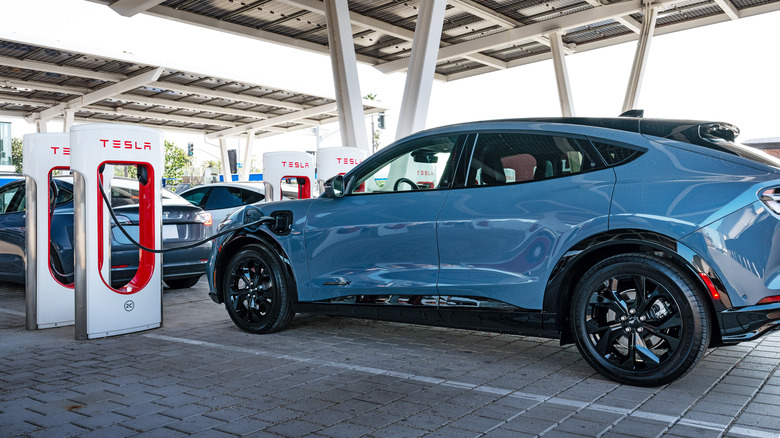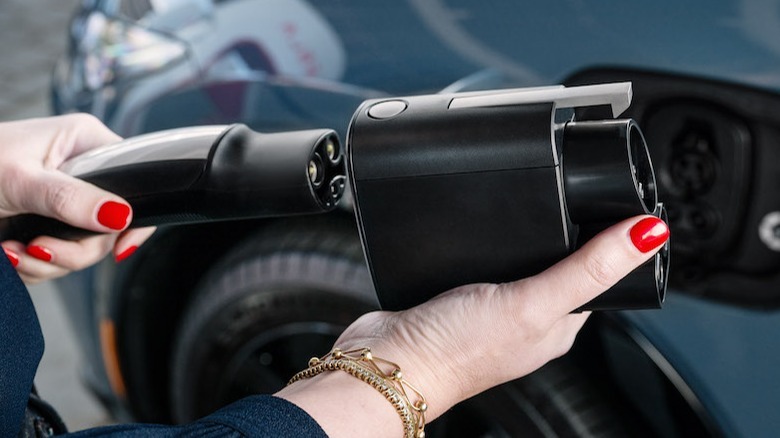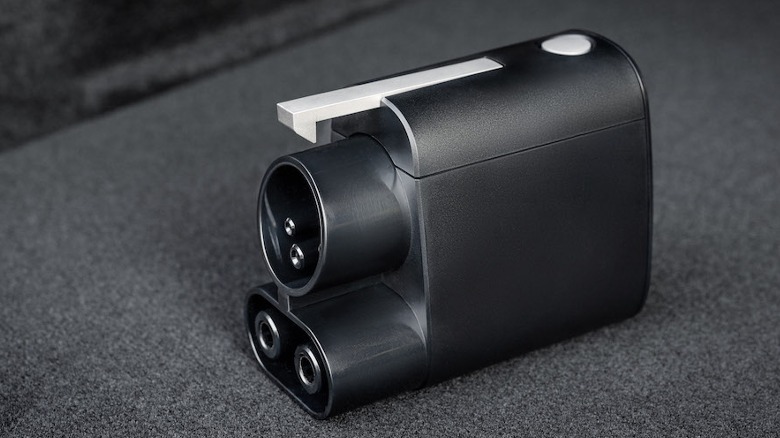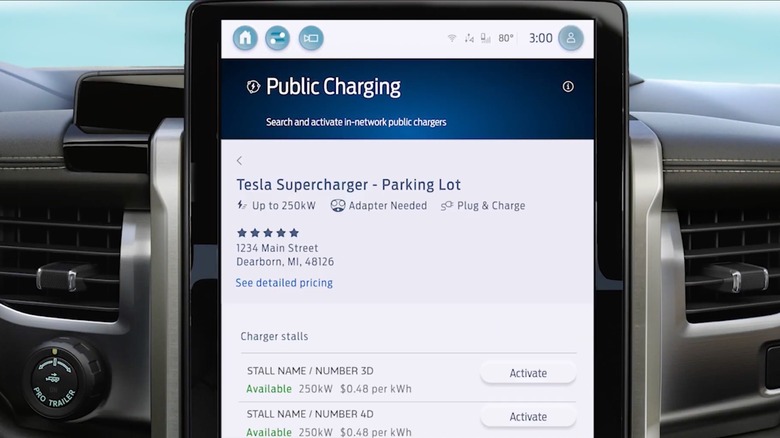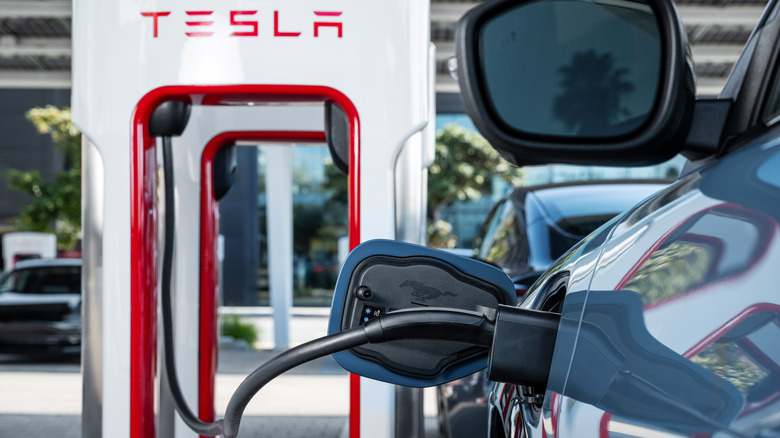Ford's EVs Can Charge At Tesla Superchargers From Today: What You Need To Know
Ford's promised Tesla Supercharger access for EV drivers goes live today, with a free adapter promising to make public charging much more accessible for vehicles like the Mustang Mach-E and F-150 Lightning. It makes Ford the first automaker to carry through on its commitment to deliver Supercharger access in North America, though it's not quite as simple as finding a charger in Tesla's app and plugging it in.
As adapters go, Ford's NACS to CCS example is pretty straightforward. The Supercharger cable plugs in on one side; the adapter plugs into the Ford EV. If Plug & Charge for public chargers is activated, the charging session should begin automatically once the vehicle and charger have done their magic handshake. Drivers won't need the Tesla app at all, though they'll also be able to initiate charging sessions either through the FordPass app or their dashboard touchscreen.
The adapter is rated for 300A at 35C but can support 500A boost rates for up to 10 minutes. Thanks to that, Ford says it's confident it can achieve full charging rate performance of its current EVs at Superchargers. While other factors — like weather conditions and battery preconditioning — will impact charging speed, the adapter shouldn't be the bottleneck.
Once the session is finished, pressing the button by the charge port will release it. A physical interlock inside will prevent the NACS plug from being disconnected while the adapter is still hooked up to the EV so that it can't be unplugged while it's charging. The NACS latching system itself has a control pilot signal system, which will automatically end the session if removed. Finally, a pair of temperature sensors in the adapter can reduce charging speed if it heats up unduly, or interrupt charging completely in a worst-case scenario.
A simple adapter for two rival charge port standards
Ford EV access at Superchargers may be going live from today, but don't expect to see the F-150 Lightning or Mustang Mach-E lined up alongside Teslas for a few weeks yet. The process for ordering a free adapter from Ford's site is straightforward: Ford will pull the delivery details and vehicle VIN from a FordPass account; you click the reserve button and that's basically it, though if you're not enrolled in the BlueOval charging network you'll be prompted to do that first. However, NACS adapters themselves aren't expected to ship until the end of March, and there's no dealer pickup option.
Adding to the delayed charging gratification is that both Ford and Tesla are keen to prevent drivers from using NACS to CCS adapters from other companies. Tesla, in fact, prohibits the use of any other adapter. On the flip side, Ford's adapter itself is refreshingly EV-agnostic. Since it lacks any sort of embedded communications system, it could be used to plug any electric vehicle with a CCS charge port into a Tesla NACS cable. That doesn't mean, of course, that non-Ford EVs can use it at Superchargers since there's a software handshake between vehicle and charger that also has to be satisfied.
Down the line, Ford is planning to switch to native NACS charging ports on its so-called second-generation electric vehicles. At that point, the automaker says, there'll be another adapter — effectively the reverse of this one — to connect CCS chargers to NACS-equipped EVs. Details of that, though, will have to wait until closer to Ford Gen 2 EVs hitting the road.
A huge increase in DC fast charger access
Ford EV drivers will have access to more than 15,000 Superchargers in the U.S. and Canada, taking the total number of DC fast chargers in the growing Ford BlueOval charging network to more than 28,000 across 7,500 locations. The eagle-eyed may have spotted that number is actually lower than Tesla's total Supercharger count for the same geography. Ford EVs won't be compatible with the older Supercharger V2 stations or with select V3 chargers which — for unspecified reasons — Tesla isn't opening up to drivers of rival electric vehicles.
Incompatible Superchargers aren't the only consideration Ford drivers should bear in mind. There won't be support at Tesla Destination Chargers, for example, the slower — but more widespread — Level 2 charging locations that help fill in the Supercharger gaps.
For that reason, Ford is recommending that drivers use the FordPass app to locate a compatible charger (which will be shown with an "Adapter Needed" symbol on the map). Later in the year, there'll be charger location info shown in Apple Maps EV routing for Apple CarPlay, and Google Maps EV routing in Android Auto, plus through the in-vehicle navigation.
Ford's adapter is free, but not forever
Exactly how much you'll pay to charge a Ford EV at a Tesla Supercharger will vary. That, Ford says, is down to Tesla itself, and as any Supercharger user will already know, rates vary depending on location. The local rate will be shown in the app, however.
Meanwhile, Ford EV owners won't want to hang about: the NACS adapter will be free between now and June 31, 2024 — one per VIN — but after that, it will be priced at $230. Unfortunately, that also applies to new Ford EV purchases: if you buy a CCS-equipped F-150 Lightning or Mustang Mach-E after July 1, you'll have to pay for the adapter yourself (or convince the dealership to throw one in as a deal sweetener).
Owners of those vehicles will also need a software update before they're Supercharger-compatible. That, Ford says, will be delivered in a series of staggered over-the-air (OTA) updates; those who have update scheduling turned on stand a better chance of seeing the new software installed first, apparently. Those with a Ford E-Transit will need to take the electric van to a dealership to have the software installed, as the EV doesn't support OTA changes to the specific system involved. On its side, Tesla is also pushing out updates to Superchargers to enable things like Plug & Charge.
Expect lines at Superchargers
Hardware and software are only one part of the equation, mind: still to play out is just what an influx of Ford EV drivers does to the Supercharger network. After all, with a few exceptions, Tesla owners have had the locations to themselves, even if the days of complimentary free charging are long gone. While owners of rival EVs plugging in should help Tesla's bottom line, it may also involve a wait for Tesla drivers.
That issue is only likely to be exacerbated, with many more automakers expecting to bring Supercharger access online for their own customers. It'll also be a new pressure test for Tesla's network, which so far has — for the most part — only had to deal with the automaker's own small range of EVs.
Nonetheless, with public charging access a longstanding concern among both potential electric vehicle buyers and existing owners alike, anything that makes living with an EV more comfortable feels like a step forward. If, in the process, that lights a fire under rival charging networks and prompts them to improve their charge speeds, uptime, and reliability, that can only be a benefit — to Ford owners and to EV drivers in general.
